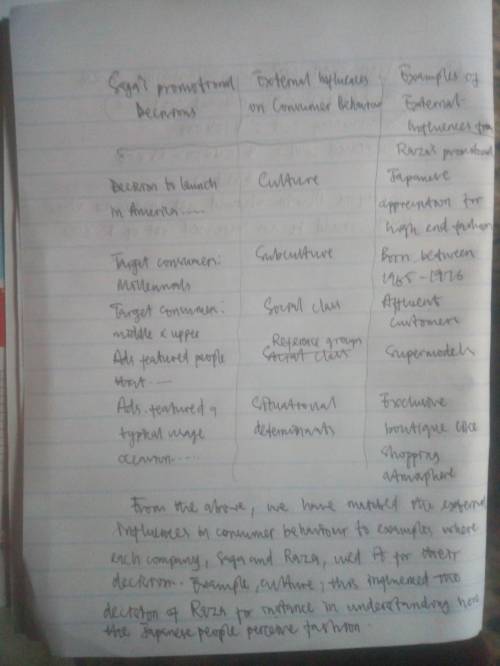
Business, 16.10.2020 05:01 vlactawhalm29
External Influences on Consumer Behavior SaGa is a European fashion store chain that specializes in accessible, trendy clothes and accessories for men and women. Its target audience includes fashion-conscious young men and women, ages 16-30. After success in Europe, SaGa is getting ready to launch its flagship stores in five U. S. markets-New York, Los Angeles, Chicago, San Francisco, and Miami. Based on its product offerings, SaGa is targeting millennials (those born between 1982 and 2000, also called gen Y). As a group, millennials are open to making impulse purchases, and are socially connected as demonstrated by their use of Twitter to tweet about products and brands. Also, based on its "accessible" price for its fashion offerings, Saga is targeting middle-to upper-middle-class millennials. SaGa's advertising agency of record was excited about the impending launch campaign in the U. S. and its first-ever foray into the American market, which is heavily influenced by celebrity and pop culture. The agency was developing a campaign that focused on "usage occasion"—the ad would show a group of friends, in their 20s, getting together for a Friday night out in the city. A social occasion such as a night out with friends, combined with the setting of a city street lined with trendy clubs and restaurants, highlighted a perfect usage occasion for wearing fashionable clothes from SaGa. In the ad, the friends walk through a busy city street that has a party atmosphere, and pass several other people whose fashion sense is not as trendy as theirs. As they pass these people, the contrast between their group and the other people is highlighted by the use of muted, fading colors (for the other people) versus bright and pleasing colors (for the group of friends wearing SaGa). The agency was thus contrasting those who do not wear SaGa, a dissociative group, with those who do. Meanwhile, Raza, a high-end fashion store chain in Europe, is planning to enter the Japanese market. RaZa's promotional strategy decisions include highlighting the purchase situation in their ads by showing the exclusive boutique store atmosphere, and by using international supermodels that denoted an aspirational group for their target audience. RaZa targeted older and more affluent consumers compared to SaGa; their target market consisted of upper-class gen X'ers in Japan (those born between 1946 and 1976). RaZa's research revealed that the Japanese culture understood and respected high-end fashion. The consumer does not make purchase decisions in isolation. A number of external factors have been identified that may influence consumer decision-making, such as culture, subcultures, social class, reference groups, and situational determinants. Match the various external (or environmental) influences on consumer behavior to the relevant situations in SaGa's promotional decisions. Then match these external influences to examples found in RaZa's decisions. Born between 1965-1976 SaGa's Promotional Decisions External Influences Examples of External on Consumer Influence from Behavior RaZa's Promotional Decisions Affluent consumers Exclusive boutique-like shopping atmosphere Decision to launch in America, which represented a new culture, compared to their existing markets. Supermodels Target consumers: millennials Situational determinants Target consumers: middle and upper-middle class Social class Ads featured people that the target consumers identify with (associative groups), and also people that the target group does not belong to (dissociative groups). Subculture Ads featured a typical usage occasion for SaGa's product offerings - a Friday night out with friends. Japanese appreciation for high-end fashion Reference groups Culture

Answers: 3
Another question on Business

Business, 22.06.2019 03:00
Journalize the following transactions that occurred in september 2015 for aquamarines. no explanations are needed. identify each accounts payable and accounts receivable with the vendor or customer name. sep. 3 purchased merchandise inventory on account from shallin wholesalers, $5,000. terms 1/15, n/eom, fob shipping point. 4 paid freight bill of $80 on september 3 purchase. 4 purchased merchandise inventory for cash of $1,700. 6 returned $500 of inventory from september 3 purchase. 8 sold merchandise inventory to hermosa company, $6,000, on account. terms 2/15, n/35. cost of goods, $2,640. 9 purchased merchandise inventory on account from thomas wholesalers, $8,000. terms 2/10, n/30, fob destination. 10 made payment to shallin wholesalers for goods purchased on september 3, less return and discount. 12 received payment from hermosa company, less discount. 13 after negotiations, received a $200 allowance from thomas wholesalers. 15 sold merchandise inventory to jordan company, $2,500, on account. terms 1/10, n/eom. cost of goods, $1,050. 22 made payment, less allowance, to thomas wholesalers for goods purchased on september 9. 23 jordan company returned $400 of the merchandise sold on september 15. cost of goods, $160. 25 sold merchandise inventory to smithsons for $1,100 on account that cost $400. terms of 2/10, n/30 were offered, fob shipping point. as a courtesy to smithsons, $75 of freight was added to the invoice for which cash was paid by aquamarines. 26 after negotiations, granted a $100 allowance to smithsons for merchandise purchased on september 25. 29 received payment from smithsons, less allowance and discount. 30 received payment from jordan company, less return.
Answers: 2

Business, 22.06.2019 04:00
Medtronic, inc., is a medical technology company that competes for customers with st. jude medical s.c., inc. james hughes worked for medtronic as a sales manager. his contract prohibited him from working for a competitor for one year after leaving medtronic. hughes sought a position as a sales director for st. jude. st. jude told hughes that his contract with medtronic was unenforceable and offered him a job. hughes accepted. medtronic filed a suit, alleging wrongful interference. which type of interference was most likely the basis for this suit? did it occur here? medtronic, inc., is a medical technology company that competes for customers with st. jude medical s.c., inc. james hughes worked for medtronic as a sales manager. his contract prohibited him from working for a competitor for one year after leaving medtronic
Answers: 2

Business, 22.06.2019 08:20
How much does a neurosurgeon can make most in canada? give me answer in candian dollar
Answers: 1

Business, 22.06.2019 12:00
In mexico, many garment or sewing shops found they could entice many young people to work for them if they offered clean, air conditioned work areas with high-quality locker rooms to clean up in after the work day. typically, traditional garment shops had to offer to get workers to apply for the hard, repetitive, and somewhat dangerous work. a. benchmark competitive wages b.compensating differentials c. monopoly wages d. wages based on human capital development of each employee
Answers: 3
You know the right answer?
External Influences on Consumer Behavior SaGa is a European fashion store chain that specializes in...
Questions










Social Studies, 03.11.2020 16:50







Mathematics, 03.11.2020 16:50







